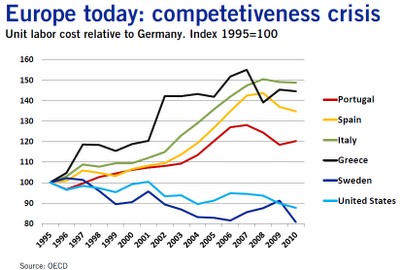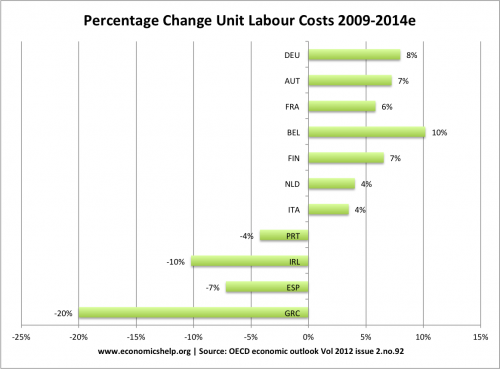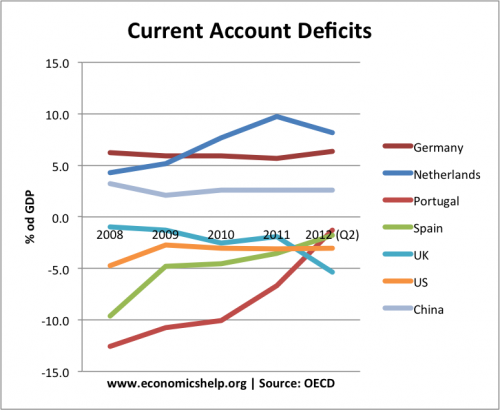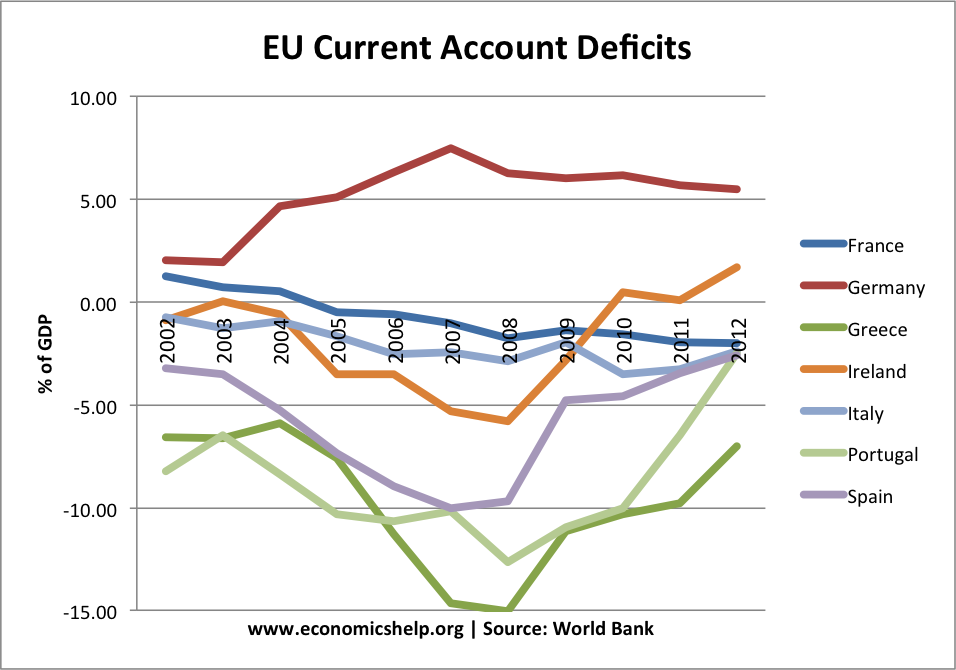In the lead up to the Euro debt crisis, there was a marked divergence in competitiveness within the Eurozone. In fact, some economists suggested that the currency imbalances were the root cause of the Eurozone fiscal crisis. (VOX article)
However, recent evidence suggests some restoration of competitiveness within the Eurozone.
We can examine competitiveness in a couple of ways. To see the divergence in competitiveness, we can look at unit labour costs. Relative to Germany, unit costs tended to rise much faster in southern Europe. The graph below shows the divergence of southern European economies compared to Germany. Remember in the Eurozone, this decline in competitiveness could not be offset by devaluation.
Decline in competitiveness in Eurozone

Competitiveness and Current Account deficits
This decline in competitiveness was reflected in substantial current account deficits in the south, and current account surpluses in the north.
By 2008/09, countries such as Portugal, Greece, Ireland and Spain had achieved record current account deficits.
To What Extent is Eurozone Competitiveness being Restored?
Unit Labour Costs 2009-2014

This research from the OECD suggests a significant restoration of competitiveness. Note, it includes forecasts for 2013 and 2014. This change in relative competitiveness would explain, at least, part of the fall in current account deficits in southern Europe.
However, it is worth bearing in mind.
- The fall in current account deficits in Portugal, Spain and Greece are partly been driven by a collapse in domestic demand – not regaining of competitiveness.
- A reduction in the current account deficit, doesn’t necessarily imply a rebalancing of internal and external demand. You could argue that given size of the recession, you would expect a country like Portugal to have a bigger current account surplus.
- The fall in unit labour costs is often been achieved by cuts in public sector wages. In the private sector, the impact on reducing unit labour costs has been less strong.(e.g. How did Portugal reduce current account deficit?)
- The German current account surplus has continued to widen to a near record 6% – suggesting Germany is still relying on export growth.
- Current account deficits are not a perfect guide to competitiveness. For example, a country may be running a surplus, such as Japan, due to an ageing population, which has more savers than borrowers.

Importance of Eurozone Competitiveness.
Some argue this improvement in competitiveness is proof that the Eurozone is on course to overcome crisis and emerge as a dynamic and vibrant economy:
“If the euro zone gets through the current acute crisis and stays on the reform path, it could eventually emerge from the crisis as the most dynamic of the major Western economies,” – Holger Schmieding, chief economist at Berenberg Bank and author of the “2012 Euro Plus Monitor,” said on Monday. CNBC – Eurozone doing quite well’
This leaves me worried that again European economists have a tendency to judge economic success on factors like relative unit labour costs, inflation – and not the much more pressing social problem of recession and unemployment. internal devaluation will eventually restore competitiveness, but it is coming at a very high social cost – it need not be so painful.
Related

